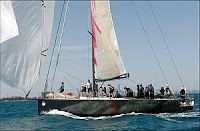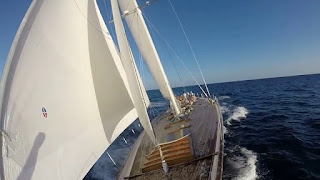Gybing Assymetricals

28 Jul 2009
Australian Sailing April 2009
IN THE 1987 America’s Cup hosted in Perth, Australia IV tested and developed a ‘secret weapon’ called a gennaker. As the name implies it was a cross between a genoa and a spinnaker, to be used on the reaching legs of the Olympic triangle courses. It had limited success but was innovative enough to send the other syndicates into hasty development programs.This sail was probably the first true attempt at a modern asymmetric spinnaker for keelboats. Today they are commonplace on every type and style of sailing boat from dinghies to super maxis and even most cruising boats have an asymmetric as their preferred downwind option.Asymmetric spinnakers have actually been around for a long time in Australia and New Zealand in the form of the ‘flatties’ used on skiffs and local dinghy classes like the Sharpies and Vee Jays. But today’s ‘asy’ is a long way removed from those sails. Sailing with asymmetric spinnakers presents a whole new way of sailing downwind, and different tactics and techniques are being developed all the time. One of the hardest parts of using one of these sails is gybing, although it must be said it’s nowhere near as hard as the old skiff flatties, where the for’ard hand had to unhook the spinnaker pole off the mast and throw it around the forestay, catch it and re-hook it up!The challengeThe reason it is so hard to successfully gybe an asymmetric spinnaker is that it has to be collapsed and then reset with the spinnaker pulled inside out so the luff remains at the front. It is similar to gybing a headsail but with the sheets outside the forestay. So the main focus should always be on keeping the spinnaker drawing as long as possible and then once it has collapsed, resetting it as quickly as possible.Firstly it is important to set up for the gybe as soon as possible. Modern asymmetric boats are very responsive to wind gusts and shifts are extremely important to catch, as there can be a difference of up to 25-30 degrees between sailing in a light, lifting patch or working low in a heading, heavy wind gust.Huge gains can be made or lost in a shifty breeze as the tactician chases the knocks and gybes away from the lifts, so it is essential to be ready to gybe quickly and efficiently.Sheet techniqueBefore gybing, make sure the new (lazy) sheet is ready to run smoothly and not tangle or knot up. When going into a gybe the trimmer should begin to ease out the old sheet as the helmsman smoothly turns into the gybe. Take up the slack on the lazy sheet as the spinnaker is eased; what we are trying to do with both helm and sheet is fly the spinnaker as long as possible.Once the sheet is eased far enough for the clew to be near the forestay, the steerer can begin to turn the boat much quicker as the old sheet is thrown off and the new sheet is brought on as quickly as possible. Bringing on the new sheet fast is important, and sometimes it can be helpful to the trimmer to have another crew member running the clew aft by hand.Inside or outsideBowsprit boats are commonplace now and the question (often with varied answers) is whether to gybe the asymmetric ‘inside’ (with the lazy sheet running between the forestay and the spinnaker luff) or ‘outside’ (with the lazy sheet run outside the spinnaker luff. The inside gybe is quicker with less sheet to pull in, but it does mean the sail will load up more. It is usual to do an inside gybe in lighter airs, but the outside gybe is usually a better and safer bet when the wind is up. Smaller boats like sportsboats can get away with inside gybing in all but extreme conditions.One thing to be careful of during an outside gybe is the lazy sheet, which can drop over the end of the sprit, into the water and under the boat. Most asymmetric spinnakers will have a small rigid battensewn into the tack, protruding forward to hold the lazy sheet up and prevent it from falling under the bow.Using the spinnaker poleFlying asymmetrics off spinnaker poles is relatively common and does have advantages as the spinnaker pole can be brought aft when you need a broader angle. In this case the asymmetric is flown in a similar way to a conventional spinnaker, except both sheets are run to the clew and both braces to the tack. An adjustable tackline from the bow is also fitted to the tack of the sail. The sail is flown conventionally with the brace on the windward side and the sheet as per normal.The tackline will act as a foreguy or kicker holding the pole down.As the gybe point approaches, ease the brace while taking up on the tackline. Once the brace is loose it can be unloaded from the pole beak and the pole brought back behind the forestay, either by transferring (unhooking the pole from the mast and sliding it aft) or by pulling the butt of the pole up the mast track as per a dip-pole gybe. Then gybe the spinnaker and once on the new gybe, the pole can be reconnected or positioned on the new side and the brace brought on to the desired pole position.MistakesOne of the most common mistakes on an asymmetric gybe is for the helmsman to become a bit disorientated through the change of course and exit too high or too low. A quick glance at the masthead wind indicator is often a good idea; if you are exiting the gybe with the indicator showing your course at about right angles to the apparent wind then you won’t be too far off the mark.Another common mistake is for the trimmer to over-sheet the spinnaker after the gybe; this will load up the boat and can result in a round up. This comes about because the trimmer has to over-sheet the spinnaker initially to set it while the boat comes onto its new angle, but once the spinnaker is full and drawing the sheet needs to be eased a generous amount to allow the boat to accelerate away on its new heading.The most catastrophic mistake is for an over-zealous helm to swing the boat through the gybe before the spinnaker sheet is eased forward. The spinnaker will be blown between the forestay and mast and it can be your day over as you try to rectify the situation. If this happens the easiest way to sort out the mess is to gybe back immediately, even if it means sailing away from your course for a while.As always with any sailing it is so important to practise. If your time as a crew is limited then try and get out early and do a few manoeuvres pre-race, particularly gybes.
The more you can do before the start, the fewer issues you will have in the race.



Comments
Post a Comment